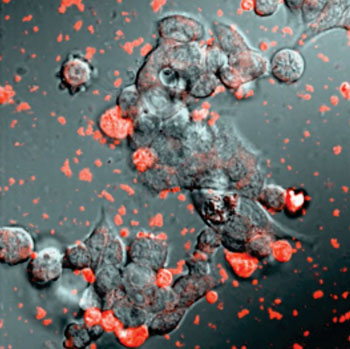Exome Delivery of the Anti-Oxidant Catalase Reduces Parkinson's Disease Symptoms in Mouse Model
By LabMedica International staff writers
Posted on 21 May 2015
The exosome delivery of the antioxidant enzyme catalase was shown to dramatically reduce symptoms of Parkinson's disease (PD) in a mouse model.Posted on 21 May 2015
Exosomes are cell-derived vesicles that are present in many and perhaps all biological fluids, including blood, urine, and cultured medium of cell cultures. The reported diameter of exosomes is between 30 and 100 nanometers, which is larger than low-density lipoproteins but much smaller than red blood cells. Exosomes, which contain RNA, proteins, lipids and metabolites that are reflective of the cell type of origin, are either released from the cell when multivesicular bodies fuse with the plasma membrane or they are released directly from the plasma membrane. Exosomes have specialized functions and play a key role in coagulation, intercellular signaling, and waste management. Consequently, there is a growing interest in the clinical applications of exosomes for prognosis, therapy, and as biomarkers for health and disease.

Image: Exosomes loaded with catalase (shown in red) efficiently interact with neurons (shown in black) to protect them from the effects of Parkinson\'s disease (Photo courtesy of Dr. Elena Batrakova, University of North Carolina).
Catalase is a key antioxidant enzyme that defends the organism against oxidative stress. It is a heme enzyme that is present in the peroxisomes of nearly all aerobic cells. Catalase converts the reactive oxygen species hydrogen peroxide to water and oxygen and thereby mitigates its toxic effects. The protein exists as a dumbbell-shaped tetramer of four identical subunits (220,000 to 350,000 Daltons). Each monomer contains a heme prosthetic group at the catalytic center.
Investigators at the University of North Carolina (Chapel Hill, USA) developed a new exosomal-based system to deliver catalase to the brain for the treatment of PD. Catalase was loaded into exosomes purified from immune system macrophages using different methods: incubation at room temperature, permeabilization with saponin, freeze–thaw cycles, sonication, or extrusion. The size of the obtained catalase-loaded exosomes was in the range of 100 to 200 nanometers. A reformation of exosomes upon sonication and extrusion, or permeabilization with saponin resulted in high loading efficiency, sustained release, and catalase preservation against proteases degradation.
Results published in the March 30, 2015, online edition of the Journal of Controlled Release indicated that exosomes were readily taken up by neuronal cells in vitro. A considerable quantity of exosomes was detected in the brains of PD mice following intranasal administration. Catalase-loaded exosome treatment provided significant neuroprotective effects in both in vitro and in vivo models of PD.
"Exosomes are engineered by nature to be the perfect delivery vehicles for proteins and genetic material," said senior author Dr. Elena Batrakova, associate professor of pharmacy at the University of North Carolina. "Catalase is a huge protein, and it is almost impossible to deliver across the blood-brain barrier alone. We use exosomes from white blood cells, which are invisible to the immune system and easily interact and fuse with the blood-brain barrier to deliver their cargo across it."
"Catalase is one of the most potent antioxidants in nature," said Dr. Batrakova. "One molecule of catalase can deactivate about one million free radicals per second, and it never stops because the enzyme is not consumed in the reaction. No small molecule drug even comes close to matching it in speed or efficiency."
Related Links:
University of North Carolina













